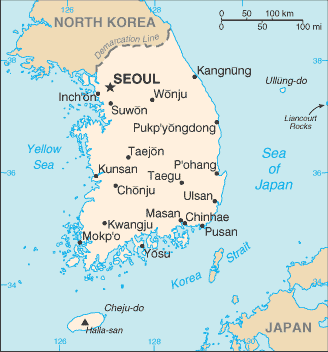Map:

Overview:
Korea was an independent kingdom under Chinese suzerainty for most of the past millennium. Following its victory in the Russo-Japanese War in 1905, Japan occupied Korea; five years later it formally annexed the entire peninsula. After World War II, a republic was set up in the southern half of the Korean Peninsula while a Communist-style government was installed in the north. During the Korean War (1950-53), US and other UN forces intervened to defend South Korea from North Korean attacks supported by the Chinese. An armistice was signed in 1953, splitting the peninsula along a demilitarized zone at about the 38th parallel. Thereafter, South Korea achieved rapid economic growth with per capita income rising to roughly 14 times the level of North Korea. In 1987, South Korean voters elected ROH Tae-woo to the presidency, ending 26 years of military dictatorships. South Korea today is a fully functioning modern democracy. In June 2000, a historic first North-South summit took place between the South's President KIM Tae-chung and the North's leader KIM Jong Il.
The People:
Population: 48,422,644 (July 2005 est.)
Age structure:
0-14 years: 19.4% (male 4,952,177/female 4,450,821)
15-64 years: 72% (male 17,715,267/female 17,147,808)
65 years and over: 8.6% (male 1,670,971/female 2,485,600) (2005 est.)
Religions:
no affiliation 46%, Christian 26%, Buddhist 26%, Confucianist 1%, other 1%
Government Type:
republic
Leader(s) to pray for:
chief of state: President ROH Moo-hyun (since 25 February 2003)
head of government: Prime Minister LEE Hae-chan (since 25 May 2004); Deputy Prime Ministers HAN Duck-soo (14 March 2005), KIM Jin-pyo (since 28 January 2005), and OH Myung (since 18 October 2004)
Source: The World Factbook
View All Countries